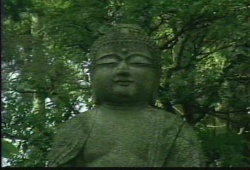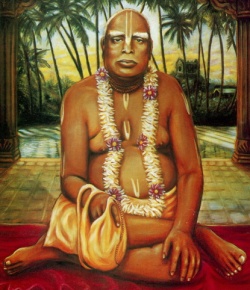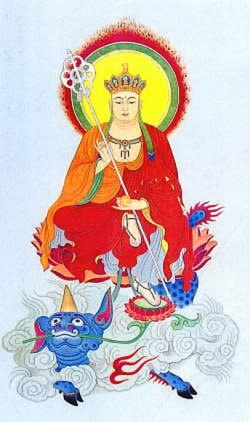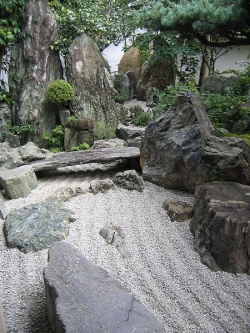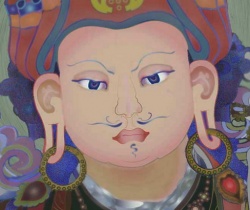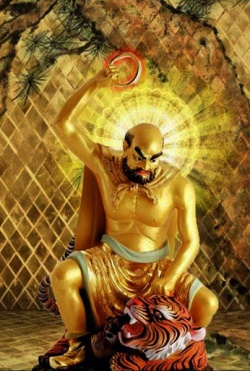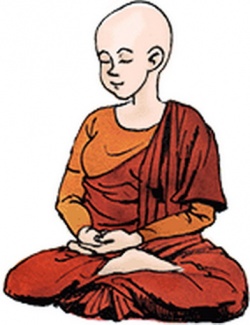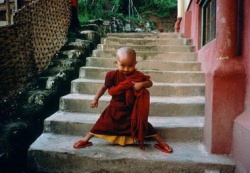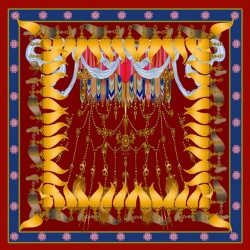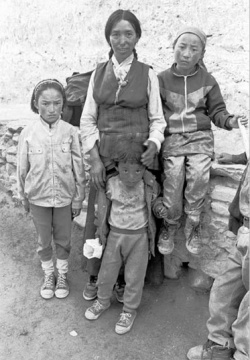Chögyam Trungpa
Chögyam Trungpa Rinpoche (Wylie: Chos rgyam Drung pa; February 28, 1939 – April 4, 1987) was a Buddhist meditation master and holder of both the Kagyu and Nyingma lineages, the eleventh Trungpa tülku, a tertön, supreme abbot of the Surmang monasteries, scholar, teacher, poet, artist,
and originator of a radical re-presentation of Shambhala vision.
Chogyam Trungpa Rinpoche (1939-1987): One of the first Tibetan masters to bring the dharma to the west. Founder of the network of Shambhala Centers.
Recognized both by Tibetan Buddhists and by other spiritual practitioners and scholars as a preeminent teacher of Tibetan Buddhism, he was a major, albeit controversial, figure in the dissemination of Tibetan Buddhism to the West, founding Vajradhatu and Naropa University and establishing the Shambhala Training method.
Among his contributions are the translation of a large number of Tibetan texts, the introduction of the Vajrayana teachings to the West, and a presentation of the Buddhadharma largely devoid of ethnic trappings.
Regarded as a mahasiddha by many senior lamas, he is seen as having embodied the crazy wisdom tradition (Tib. yeshe chölwa) of Tibetan Buddhism. Some of his teaching methods and actions were the topic of controversy during his lifetime and afterwards.
Biography
Early years
[[File:Khenpo gangshar2.jpg|thumb|Khenpo Gangshar (left) and Chögyam Trungpa)]
Born in the Kham region of Tibet in February 1939, Chögyam Trungpa was eleventh in the line of Trungpa tülkus, important figures in the Kagyu lineage, one of the four main schools of Tibetan Buddhism.
Among his three main teachers were Jamgon Kongtrul of Sechen, HH Dilgo Khyentse Rinpoche, and Khenpo Gangshar.
The name Chögyam is a contraction of Chökyi Gyamtso (Tibetan: ཆོས་ཀྱི་རྒྱ་མཚོ་, Wylie: Chos-kyi Rgya-mtsho), which means "ocean of dharma". Trungpa (Tibetan: དྲུང་པ་, Wylie: Drung-pa) means "attendant".
He was deeply trained in the Kagyu tradition and received his khenpo degree at the same time as Thrangu Rinpoche; they continued to be very close in later years.
Chögyam Trungpa was also trained in the Nyingma tradition, the oldest of the four schools, and was an adherent of the ri-mé ("nonsectarian") ecumenical movement within Tibetan Buddhism, which aspired to bring together and make available all the valuable teachings of the different schools, free of sectarian rivalry.
Already installed as the head of the Surmang monasteries in eastern Tibet, Chögyam Trungpa followed the Dalai Lama who fled Tibet during the ultimately unsuccessful 1959 Tibetan uprising against the Chinese communists. He was 20 years old, and he led his own party of monks across the Himalayas on foot and on horseback into India.
From 1959-1963, by appointment of the Dalai Lama, Chögyam Trungpa served as the spiritual advisor for the Young Lamas Home School in Dalhousie, India.
Early teachings in the West
In exile in India, Trungpa began his study of English. In 1963, with the assistance of sympathetic westerners, he received a Spalding sponsorship to study Comparative Religion at Oxford University in England.
In 1967 he and Akong Rinpoche were invited by the Johnstone House Trust in Scotland to take over a meditation center on the departure of the western Theravadan monk named Anandabodhi, which then became Samye Ling, the first Tibetan Buddhist monastery in the West.
At this monastery in Scotland, future actor and musician David Bowie was one of Chogyam Trungpa's meditation pupils. In 1970, after a break with his fellow lama Akong Tulku Rinpoche, Trungpa moved to the United States at the invitation of several students.
Shortly after his move to Scotland, a variety of experiences, including a car accident that left him partially paralyzed on the left side of his body, led Trungpa to the decision to give up his monastic vows and work as a lay teacher.
This decision was principally motivated by the intention to undercut the temptation of students becoming distracted by exotic cultures and dress, and by their preconceptions of how a guru should behave.
He drank, smoked, slept with students, and often kept students waiting for hours before giving teachings.
Much of his behavior has been asserted as deliberately provocative and sparked controversies that continue to this day.
In one account, he encouraged students to give up smoking marijuana claiming that the smoking was not of benefit to their spiritual progress, and that it exaggerated neurosis.
Students were often angered, unnerved and intimidated by him, but many remained fiercely loyal, committed, and devoted.
Upon moving to the United States in 1970, Trungpa traveled around North America, gaining renown for his unique ability to present the essence of the highest Buddhist teachings in a form readily understandable to western students.
During this period, he conducted thirteen Vajradhatu Seminaries, three-month residential programs at which he presented a vast body of Buddhist teachings in an atmosphere of intensive meditation practice.
The seminaries also had the important function of training his students to become teachers themselves.
Introduction of the Vajrayana
Trungpa was one of the first teachers to introduce the esoteric practice of the Vajrayana to the West.
According to Khenpo Tsultrim Gyamtso, "The one who mainly spread the Vajrayana in the West was Trungpa Rinpoche."
In contrast to its traditional presentation in Tibet, where the esoteric practices are largely the domain of the monastic sangha, in America Trungpa introduced the Vajrayana to the lay sangha.
The presentation of these teachings gave rise to some criticism.
According to a former student, Stephen Butterfield, "Trungpa told us that if we ever tried to leave the Vajrayana, we would suffer unbearable, subtle, continuous anguish, and disasters would pursue us like furies" Other Vajrayana teachers, as well, also warn their students about the dangers of the esoteric path.
Butterfield noted "disquieting resemblances" to cults, and "to be part of Trungpa's inner circle, you had to take a vow never to reveal or even discuss some of the things he did."
However, Butterfield also notes that "This personal secrecy is common with gurus, especially in Vajrayana Buddhism, and acknowledges that Trungpa's organization is anything but a cult:
"a mere cult leaves you disgusted and disillusioned, wondering how you could have been a fool. I did not feel that charlatans had hoodwinked me into giving up my powers to enhance theirs. On the contrary, mine were unveiled.
Meditation and education centers
[[File:Karme chöling purkong.jpg|thumb|The purkhang at Karmê Chöling)]
In 1973, Trungpa established Vajradhatu, encompassing all his North American institutions, headquartered in Boulder, Colorado. Trungpa also founded more than 100 meditation centers throughout the world.
Originally known as Dharmadhatus, these centers, now more than 150 in number, are known as Shambhala Meditation Centers.
He also founded retreat centers for intensive meditation practice including Shambhala Mountain Center in Red Feather Lakes, CO, Karmê Chöling in Barnet, VT and Gampo Abbey in Cape Breton, Nova Scotia.
In 1974, Trungpa founded the Naropa Institute, which later became Naropa University, in Boulder, Colorado.
Naropa was the first accredited Buddhist university in North America.
Chogyam Trungpa hired Allen Ginsberg to teach poetry and William Burroughs to teach literature.
He had a number of notable students, among whom were Pema Chödrön, Allen Ginsberg, Peter Orlovsky, Anne Waldman, Diane di Prima, Peter Lieberson, José Argüelles, David Nichtern, Ken Wilber, David Deida, Francisco Varela, and Joni Mitchell who portrayed Trungpa in the song "Refuge of the Roads" on her 1976 album Hejira. Ginsberg, Waldman, and di Prima were also teachers at Naropa University.
Some important but less well-known students, whom he taught in England and in the USA, were Alf Vial, Rigdzin Shikpo (né Michael Hookham), Jigme Rinzen (né P. Howard Useche), Ezequiel Hernandez who later became known as Keun-Tshen Goba after setting up his first meditation center in Venezuela, Miguel Otaola (aka Dorje Khandro), Francisco Salas Roche, and Francesca Fremantle. Rigdzin Shikpo went on to continue Chögyam Trungpa Rinpoche's teachings from a primarily Nyingma rather than a Kagyü point of view in the Longchen Foundation.
Shambhala vision
In 1976, Trungpa began giving a series of secular teachings, some of which were gathered and presented as the Shambhala Training, inspired by his vision (see terma) of the legendary Kingdom of Shambhala.
Trungpa had actually started writing about Shambhala before his 1959 escape from Tibet to India, but most of those writings were lost during the escape.
In his view not only was individual enlightenment not mythical, but Shambhala Kingdom referred to an enlightened society that could in fact be actualized.
The practice of Shambhala vision is to use mindfulness/awareness meditation as a way to connect with one's basic goodness and confidence.
It is presented as a path that "brings dignity, confidence, and wisdom to every facet of life." The enlightened society it proposes would be led by himself as sakyong (Tib. earth protector) and his wife as queen-consort or sakyong wangmo.
Shambhala vision is described as a non-religious approach, rooted in meditation and accessible to individuals of any, or no, religion.
In Shambhala terms, it is possible, moment by moment, for individuals to establish enlightened society. His book, Shambhala: The Sacred Path of the Warrior, provides a concise collection of the Shambhala views.
According to Trungpa, it was his intention to propagate the kingdom of Shambala that provided the necessary inspiration to leave his homeland and make the arduous journey to India and the West.
Work with arts and sciences
From the beginning of his time in America, Chögyam Trungpa passionately encouraged his students to integrate a contemplative approach into all of their everyday activities.
In addition to making a variety of traditional contemplative practices available to the community, he also incorporated the many already-existing special interests of his students, evolving specialized teachings on how to apply a meditative approach to these various disciplines.
These disciplines included kyūdō (Japanese archery), calligraphy, ikebana (flower arranging), sado (Japanese tea ceremony), dance, theater, film, poetry, as well as health care and psychotherapy. His aim was, in his own words, to bring "art to everyday life."
He founded the Nalanda Foundation in 1974 as an umbrella organization for these activities.
Death
On September 28, 1986, Trungpa, in failing health due to the auto accident in his youth and to years of heavy alcohol use, suffered cardiac arrest, subsequent to which his condition deteriorated further, requiring intensive care at the hospital,
then at his home, and finally back at the hospital in mid-March 1987, where he died on April 4.
His wife Diana Mukpo wrote in 2006 that: "Although he had many of the classic health problems that develop from heavy drinking, it was in fact more likely the diabetes and high blood pressure that led to abnormal blood sugar levels and then the cardiac arrest".
However, when asked in a November 2008 interview, "What was he ill with? What did he die of?," his doctor Mitchell Levy replied, "He had chronic liver disease related to his alcohol intake over many years."
One of his nursing attendants reports that in his last months, he suffered from the classic symptoms of terminal alcoholism and cirrhosis, yet continued drinking heavily.
She adds, "At the same time there was a power about him and an equanimity to his presence that was phenomenal, that I don't know how to explain."
He is reported to have remained in a state of samādhi for five days after his death, his body not immediately decaying and his heart remaining warm.
His body was packed in salt and laid into a wooden box that was conveyed to Karmê Chöling.
A number of observers have reported that his cremation there on May 26, 1987 was accompanied by various atmospheric effects and other signs traditionally viewed as marks of enlightenment.
These included the appearance of rainbows, of eagles circling, and of a cloud in the shape of an Ashe.
Continuation of the Shambhala lineage
Upon the death of Chögyam Trungpa, the leadership of Vajradhatu was first carried on by his American disciple, appointed regent and Dharma heir, Ösel Tendzin (Thomas Rich), and then by Trungpa's eldest son and Shambhala heir, Sakyong Mipham Rinpoche.
The next Trungpa tülku, Chokyi Sengay, was recognized in 1991 by Tai Situ Rinpoche.
Acclaim
Major lineage holders of his own Tibetan Buddhist traditions and many other Buddhist teachers supported his work.
In 1974, Trungpa invited the Karmapa, head of the Karma Kagyu lineage, to come to the west and offer teachings. Based on this visit, the Karmapa proclaimed Trungpa to be one of the principal Kagyu lineage holders in the west:
- The ancient and renowned lineage of the Trungpas, since the great siddha Trungmase Chökyi Gyamtso Lodrö, possessor of only holy activity, has in every generation given rise to great beings.
Awakened by the vision of these predecessors in the lineage, this my present lineage holder, Chökyi Gyamtso Trungpa Rinpoche, supreme incarnate being, has magnificently carried out the vajra holders discipline in the land of America, bringing about the liberation of students and ripening them in the dharma.
This wonderful truth is clearly manifest.
- Accordingly, I empower Chögyam Trungpa Vajra Holder and Possessor of the Victory Banner of the Practice Lineage of the Karma Kagyu. Let this be recognized by all people of both elevated and ordinary station.
In 1981, Chögyam Trungpa and his students hosted the Fourteenth Dalai Lama in his visit to Boulder, Colorado.
Of Trungpa, he later wrote, "Exceptional as one of the first Tibetan lamas to become fully assimilated into Western culture, he made a powerful contribution to revealing the Tibetan approach to inner peace in the West."
Chögyam Trungpa also received support from one of his own main teachers, Dilgo Khyentse Rinpoche, head of the Nyingma lineage.
In addition to numerous sadhanas and poems dedicated to Trungpa, Khyentse Rinpoche wrote a supplication after Trungpa's death specifically naming him a mahasiddha.
Among other Tibetan lamas to name Trungpa as a mahasiddha are the Sixteenth Karmapa, Thrangu Rinpoche, Khenpo Tsultrim Gyamtso Rinpoche and Tai Situpa.
The Dzogchen Ponlop Rinpoche said, "As taught in the Buddhist scriptures, there are nine qualities of a perfect master of buddhadharma. The eleventh Chögyam Trungpa Rinpoche possessed all nine of these."
Suzuki Roshi, founder of the San Francisco Zen Center and Tassajara Zen Mountain Center, and another important exponent of Buddhism to western students, described Trungpa Rinpoche in the context of a talk about emptiness:
- The way you can struggle with this is to be supported by something, something you don't know. As we are human beings, there must be that kind of feeling. You must feel it in this city or building or community. So whatever community it may be, it is necessary for it to have this kind of spiritual support.
- That is why I respect Trungpa Rinpoche. He is supporting us.
You may criticize him because he drinks alcohol like I drink water, but that is a minor problem. He trusts you completely. He knows that if he is always supporting you in a true sense you will not criticize him, whatever he does.
And he doesn't mind whatever you say. That is not the point, you know. This kind of big spirit, without clinging to some special religion or form of practice, is necessary for human beings.
Gehlek Rinpoche, who lived with Trungpa Rinpoche when they were young monks in India and later visited and taught with him in the U.S., remarked:
- He was a great Tibetan yogi, a friend, and a master. The more I deal with Western Dharma students, the more I appreciate how he presented the dharma and the activities that he taught.
Whenever I meet with difficulties, I begin to understand – sometimes before solving the problem, sometimes afterward – why Trungpa Rinpoche did some unconventional things.
I do consider him to be the father of Tibetan Buddhism in the United States. In my opinion, he left very early – too early. His death was a great loss. Everything he did is significant.
Diana Mukpo, his wife, stated:
- First, Rinpoche always wanted feedback. He very, very much encouraged his students’ critical intelligence.
One of the reasons that people were in his circle was that they were willing to be honest and direct with him.
He definitely was not one of those teachers who asked for obedience and wanted their students not to think for themselves. He thrived, he lived, on the intelligence of his students. That is how he built his entire teaching situation.
- From my perspective, I could always be pretty direct with him. Maybe I was not hesitant to do that because I really trusted the unconditional nature of our relationship. I felt there was really nothing to lose by being absolutely direct with him, and he appreciated that.
Controversies
Chögyam Trungpa's style of teaching was often unconventional. In his own words, "When we talk about compassion, we talk in terms of being kind.
But compassion is not so much being kind; it is being creative to wake a person up."
He did not encourage his students to imitate his own behavior, and he was troubled by those who felt empowered by his example to do whatever they wanted and manipulate people.
As the third Jamgön Kongtrül explained in a teaching given to students of Chögyam Trungpa, "You shouldn't imitate or judge the behavior of your teacher, Chögyam Trungpa Rinpoche, unless you can imitate his mind."
Trungpa's sexuality has been one of the sources of controversy, as he cultivated relations with a number of his female students.
Tenzin Palmo, who met him in 1962 while he was still at Oxford, did not become one of his consorts.
She mentions she refused his advances at the time because he had presented himself as "a pure monk."
However, she said had she known that Trungpa began having sexual relations with women at age thirteen, she would not have declined, considering that in the higher stages of Tibetan Buddhist tantra, sexual relations (especially with tertöns) are a means of enhancing spiritual insights. Trungpa formally renounced his monastic vows in 1969.
Trungpa was also known for smoking tobacco and for his liberal use of alcohol; many who knew him characterized him as an alcoholic.
He began drinking occasionally shortly after arriving in India. Before his coming to America, Trungpa drove a sports car into a joke shop in Dumfries, Scotland.
While his companion was not seriously injured, Trungpa was left partially paralyzed. Later, he described this event as a pivotal moment which inspired the course of his teachings. Some accounts ascribe the accident to drinking. Others suggest he may have had a stroke. According to Trungpa himself, he blacked out.
He often combined drinking with teaching.
David Chadwick recounts: "Suzuki Roshi asked Trungpa to give a talk to the students in the zendo the next night.
Trungpa walked in tipsy and sat on the edge of the altar platform with his feet dangling. But he delivered a crystal-clear talk, which some felt had a quality – like Suzuki's talks – of not only being about the dharma but being itself the dharma."
However, in some instances, he was too drunk to walk, and had to be carried. Also, according to the Steinbecks, on a couple of occasions his speech was unintelligible. One woman reported serving him "big glasses of gin first thing in the morning."
Two former students of Trungpa, John Steinbeck IV and his wife, wrote a sharply critical memoir of their lives with him in which they claim that, in addition to alcohol, Trungpa used $40,000 a year worth of cocaine, and used Seconal to come down from the cocaine.
The cocaine use, say the Steinbecks, was kept secret from the wider Vajradhatu community.
An incident that became a cause célèbre among some poets and artists was the Halloween party at the Snowmass Colorado Seminary in the fall of 1975, held during a 3-month period of intensive meditation and study of the Hinayana, Mahayana, and Vajrayana vehicles of Tibetan Buddhism.
The poet W. S. Merwin had arrived that summer at the Naropa Institute and been told by Allen Ginsberg that he ought to visit the seminary.
Although he had not gone through the several years' worth of study and preparatory mind training required, Merwin was insistent he attend, and Trungpa eventually granted his request – along with his girlfriend as well.
At seminary the couple stayed to themselves.
At the Halloween party, after many, including Trungpa himself, had taken off their clothes, Merwin was asked to join the event, but refused.
On Trungpa's orders, his Vajra Guard forced entry into the poet's locked and barricaded room; brought him and his girlfriend, Dana Naone, against their will, to the party; and eventually stripped them of all their clothes, with onlookers ignoring Naone's pleas for help and for someone to call the police.
The next day Trungpa asked Merwin and Naone to remain at the Seminary as either students or guests.
They agreed to stay for several more weeks to hear the Vajrayana teachings, with Trungpa's promise that "there would be no more incidents," and Merwin and Naone's assertion that "it would be with no guarantees of obedience, trust, or personal devotion to him."
They left immediately after the last talk. In a 1977 letter to members of a Naropa class investigating the incident, Merwin concluded,
- My feelings about Trungpa have been mixed from the start. Admiration, throughout, for his remarkable gifts;
and reservations, which developed into profound misgivings, concerning some of his uses of them. I imagine, at least, that I've learned some things from him (though maybe not all of them were the things I was 'supposed' to learn) and some through him, and I'm grateful to him for those.
I wouldn't encourage anyone to become a student of his. I wish him well.
Author Jeffery Paine commented on this incident that "[s]eeing Merwin out of step with the rest, Trungpa could have asked him to leave, but decided it was kinder to shock him out of his aloofness."
However, he also notes the outrage felt in particular by poets such as Robert Bly and Kenneth Rexroth, who began calling Trungpa a fascist.
Trungpa's choice of Westerner Ösel Tendzin as his dharma heir was controversial, as Tendzin would be the first Western Tibetan Buddhist lineage holder and Vajra Regent.
This was exacerbated by Tendzin's own behavior as lineage holder. Tendzin, while knowingly carrying HIV, was sexually involved with students, one of whom became infected and died.
Rick Fields, historian of Buddhism in America, writes that Trungpa "caused more trouble, and did more good, than anyone I'll ever know."
Chronology
1940: Born in Kham, Eastern Tibet. Enthroned as eleventh Trungpa Tulku, Supreme Abbot of Surmang Monasteries, and Governor of Surmang District. Some put his birth in 1939.
1944–59: Studies traditional monastic disciplines, meditation, and philosophy, as well as calligraphy, thangka painting, and monastic dance.
1947: Ordained as a shramanera (novice monk).
1958: Receives degrees of Kyorpön (Doctor of Divinity) and Khenpo (Master of Studies). Ordained as a bhikshu (full monk).
1959–60: Follows the Dalai Lama to India during the 1959 Tibetan uprising, which failed to overthrow the Chinese government
1960–63: By appointment of the Dalai Lama, serves as spiritual advisor to the Young Lamas' Home School in Dalhousie, India.
1962: Fathers first son, Ösel Rangdröl (Mukpo), by a nun later referred to as Lady Kunchok Palden (or Lady Konchok Palden).
1963–67: Attends Oxford University on a Spaulding scholarship, studying comparative religion, philosophy, and fine arts. Receives instructor's degree of the Sogetsu School of ikebana (Japanese flower arrangement)
1967: Founds Samyê-Ling, a meditation center in Dumfriesshire, Scotland.
1968: Receives The Sadhana of Mahamudra terma text while on retreat in Paro Taktsang, a sacred cliffside monastery in Bhutan.
1969: Becomes the first Tibetan British subject. Injured in a car accident, leaving him partially paralyzed. Relinquishes monastic vows and robes.
1970: Renounces monastic vows and marries wealthy sixteen year old disciple Diana Judith Pybus.
Arrives in North America. Establishes Tail of the Tiger, a Buddhist meditation and study center in Vermont, now known as Karmê Chöling.
Establishes Karma Dzong, a Buddhist community in Boulder, Colorado.
1971: Begins teaching at University of Colorado. Establishes Rocky Mountain Dharma Center, now known as Shambhala Mountain Center, near Fort Collins, Colorado.
1972: Initiates Maitri, a therapeutic program that works with different styles of neurosis using principles of the five buddha families.
Conducts the Milarepa Film Workshop, a program which analyzes the aesthetics of film, on Lookout Mountain, Colorado.
1973: Founds Mudra Theater Group, which stages original plays and practices theater exercises, based on traditional Tibetan dance.
Incorporates Vajradhatu, an international association of Buddhist meditation and study centers, now known as Shambhala International.
Establishes Dorje Khyung Dzong, a retreat facility in southern Colorado.
Conducts first annual Vajradhatu Seminary, a three-month advanced practice and study program.
1974: Incorporates Nalanda Foundation, a nonprofit, nonsectarian educational organization to encourage and organize programs in the fields of education, psychology, and the arts.
Hosts the first North American visit of The Sixteenth Gyalwang Karmapa, head of the Karma Kagyü lineage.
Founds The Naropa Institute, a contemplative studies and liberal arts college, now fully accredited as Naropa University. Forms the organization that will become the Dorje Kasung, a service group entrusted with the protection of the buddhist teachings and the welfare of the community.
1975: Forms the organization that will become the Shambhala Lodge, a group of students dedicated to fostering enlightened society.
Founds the Nalanda Translation Committee for the translation of Buddhist texts from Tibetan and Sanskrit. Establishes Ashoka Credit Union.
1976: Hosts the first North American visit of Dilgo Khyentse Rinpoche, revered meditation master and scholar of the Nyingma lineage.
Hosts a visit of Dudjom Rinpoche, head of the Nyingma lineage. Empowers Thomas F. Rich as his dharma heir, known there after as Vajra Regent Ösel Tendzin.
Establishes the Kalapa Court in Boulder, Colorado, as his residence and a cultural center for the Vajradhatu community.
Receives the first of several Shambhala terma texts (see termas). These comprise the literary source for the Shambhala teachings. Founds Alaya Preschool in Boulder, Colorado.
1977: Bestows the Vajrayogini abhisheka for the first time in the West for students who have completed ngöndro practice.
Establishes the celebration of Shambhala Day.
Observes a year-long retreat in Charlemont, Massachusetts.
Founds Shambhala Training to promote a secular approach to meditation practice and an appreciation of basic human goodness. Visits Nova Scotia for the first time.
1978: Conducts the first annual Magyal Pomra Encampment, an advanced training program for members of the Dorje Kasung.
Conducts the first annual Kalapa Assembly, an intensive training program for advanced Shambhala teachings and practices. Conducts the first Dharma Art seminar. Forms Amara, an association of health professionals.
Forms the Upaya Council, a mediation council providing a forum for resolving disputes. Establishes the Midsummer's Day festival and Children's Day.
1979: Empowers his eldest son, Ösel Rangdröl Mukpo, as his successor and heir to the Shambhala lineage.
Founds the Shambhala School of Dressage, an equestrian school under the direction of his wife, Lady Diana Mukpo. Founds Vidya Elementary School in Boulder, Colorado.
1980–83: Presents a series of environmental installations and flower arranging exhibitions at art galleries in Los Angeles, San Francisco, Denver, and Boulder.
1980: Forms Kalapa Cha to promote the practice of traditional Japanese Tea Ceremony. With the Nalanda Translation Committee, completes the first English translation of The Rain of Wisdom.
1981: Hosts the visit of the 14th Dalai Lama to Boulder, Colorado.
Conducts the first annual Buddhist-Christian Conference in Boulder, Colorado, exploring the common ground between Buddhist and Christian contemplative traditions.
Forms Ryuko Kyūdōjō to promote the practice of Kyūdō under the direction of [[[Shibata]] Kanjuro]] Sensei, bow maker to the Emperor of Japan. Directs a film, Discovering Elegance, using footage of his environmental installation and flower arranging exhibitions.
1982: Forms Kalapa Ikebana to promote the study and practice of Japanese flower arranging.
1983: Establishes Gampo Abbey, a Karma Kagyü monastery located in Cape Breton, Nova Scotia, for Western students wishing to enter into traditional monastic discipline. Creates a series of elocution exercises to promote precision and mindfulness of speech.
1984–85: Observes a year-long retreat in Mill Village, Nova Scotia.
1986: Moves his home and the international headquarters of Vajradhatu to Halifax, Nova Scotia.
1987: Dies of an alcohol-related illness, April 4, in Halifax; cremated May 26 at Karmê Chöling. (His followers have constructed a chorten or stupa, the The Great Stupa of Dharmakaya, located near Red Feather Lakes, Colorado, for his remains.) 1989: The child recognized as his reincarnation, Chokyi Sengay, is born in Derge, Tibet; recognized two years later by Tai Situ Rinpoche.
Bibliography
- Born in Tibet (1966), autobiography, story of escaping from Tibet.
- Meditation in Action (1969)
- Mudra (1972)
- Cutting Through Spiritual Materialism (1973)
- The Dawn of Tantra, by Herbert V. Guenther and Chögyam Trungpa (1975)
- Glimpses of Abhidharma (1975)
- The Tibetan Book of the Dead: The Great Liberation through Hearing in the Bardo, translated with commentary by Francesca Fremantle and Chögyam Trungpa (1975)
- The Myth of Freedom and the Way of Meditation (1976)
- The Rain of Wisdom (1980)
- Journey without Goal: The Tantric Wisdom of the Buddha (1981)
- The Life of Marpa the Translator (1982)
- First Thought Best Thought: 108 Poems (1983)
- Shambhala: The Sacred Path of the Warrior (1984)
- Crazy Wisdom (1991)
- The Heart of the Buddha (1991)
- Orderly Chaos: The Mandala Principle (1991)
- Secret Beyond Thought: The Five Chakras and the Four Karmas (1991)
- The Lion's Roar: An Introduction to Tantra (1992)
- Transcending Madness: The Experience of the Six Bardos (1992)
- Training the Mind and Cultivating Loving Kindness (1993)
- Glimpses of Shunyata (1993)
- The Art of Calligraphy: Joining Heaven and Earth (1994)
- Illusion's Game: The Life and Teaching of Naropa (1994)
- The Path Is the Goal: A Basic Handbook of Buddhist Meditation (1995)
- Dharma Art (1996)
- Timely Rain: Selected Poetry of Chögyam Trungpa (1998)
- Great Eastern Sun: The Wisdom of Shambhala (1999)
- Glimpses of Space: The Feminine Principle and Evam (1999)
- The Essential Chögyam Trungpa (2000)
- Glimpses of Mahayana (2001)
- Glimpses of Realization (2003)
- The Collected Works of Chögyam Trungpa, Volumes One through Eight (2003)
- True Command: The Teachings of the Dorje Kasung, Volume I, The Town Talks (2004)
- The Sanity We Are Born With: A Buddhist Approach to Psychology (2005)
- The Teacup & the Skullcup: Chogyam Trungpa on Zen and Tantra (2007)

